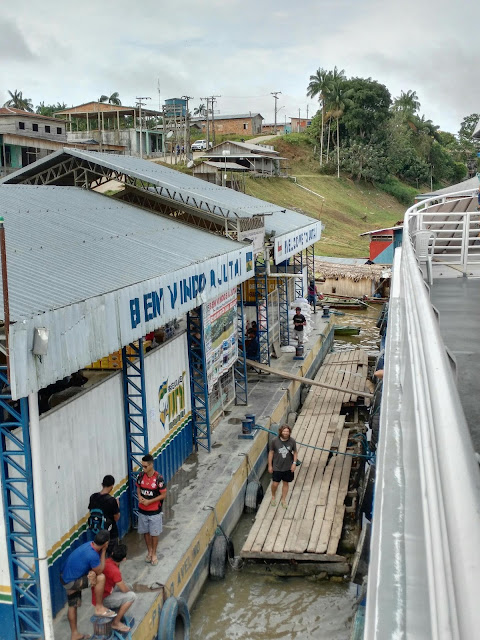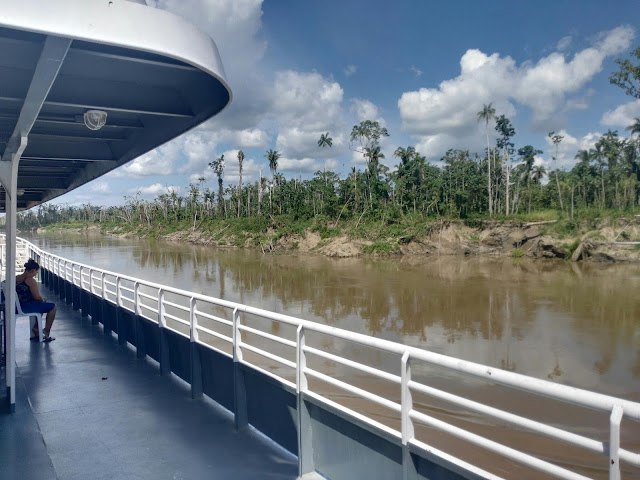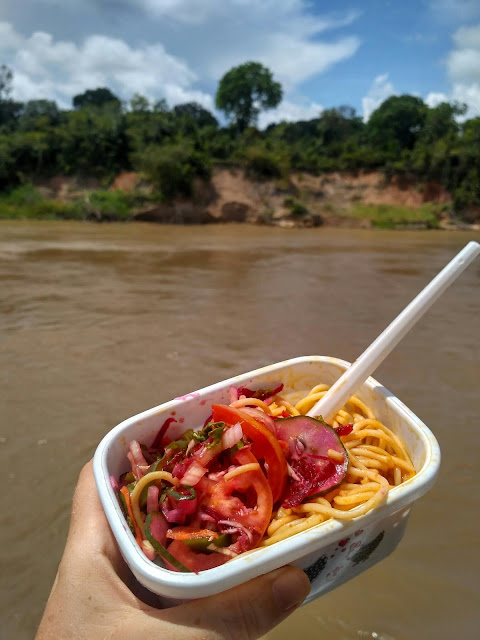They boat trip from Manaus to Tabatinga was to be the longest in a series of long boat trips up the Amazon. We'd be spending seven days and six nights on the F/B Fenix II (a redundant, or at least predictable name. Though slightly confusing if taken literaturally, as the Fenix I was docked at the next berth over and was clearly not just a heap of ashes).
You might think (or you might not) that a week heading through the Amazon forest with no stops at all for the first three days might get a bit, well, tedious. If you thought the former you'd be partly right. But only partly. True, the riverbanks were filled with nothing but forest the vast majority of the time. But it's only by spending this long with the river that we you can see the subtle differences in it.
The middle two days of the trip were probably the wildest jungle we'd seen anywhere on our journey. Scarcely a single thatched roof home or a solitary dugout canoe. For the last two days came a regular stream of Amerindian villages where we'd stop to unload floor tiles, cement, refrigerators, buckets of margarine and bewildering quantities of frozen chickens (over 1200 in Jutai alone). On some days the river would flow fast with eddies and bubbles. On day five it was smooth as glass almost the entire day, probably the prettiest the Amazon ever looked for us. Sometimes the banks would be steep and muddy, other times wide, sprawling beaches with kilometres-long sandbars in the middle, and still elsewhere they'd be dark red rock cliffs. It was similar to taking the Indian Pacific train across the Nullarbor in Western Australia. Or perhaps even more similar to the way people describe the Trans-Siberian train trip across the Taiga. Yes, it's huge amounts of sameness. But you need that sameness to begin to appreciate its scale, as well as the subtle differences from place to place.
The weather provided novelty as well. The daytim temperature ranged from pleasantly warm to swelteringly sweaty. In the night it was occasionally even cool enough that I needed to put a jersey on. On a couple evenings we saw some of the most spectacular thunderstorms I've ever witnessed. On night three the sky spent more time lit by lightning than dark for almost an hour. On night four one spent a good portion of the evening right overhead, wind whipping the rain onto the deck, prompting us to move out hammocks into the mostly empty indoor cabin on the upper deck from the almost entirely empty covered but wall-less rear deck.
One thing I've still not figured out is why the Brazilians on Amazon boats seem to prefer being on the mid decks. Closer to the engines and usually the toilets, slightly cooler, but with less breeze and fewer nice views.
On our boat the much emptier upper deck had Sarah and I, a Brazilian mom and her three kids, a couple of young-to-middle-aged Brazilian men, a Peruvian mom and teenage son, a Croatian who lived in Colombia and was headed home to Medellin and three Venezuelan migrants. We made friends with all of these, especially the Venezuelans, who took to greeting me with a (very friendly) cry of "Gringo!" whenever I appeared. This was partly done by sharing our bottles of Cachaça, which we mixed up with juice and powdered drink mix. First was coconut milk and pineapple drink to make budgo piña coladas, then when the coconut milk ran out with lime drink and fresh lime juice to make similarly pseudo capirinhas.
In addition to the drinks, we'd brought plenty of snacks for the trip. These weren't really necessary, as this was the first trip we took where food was included in the fare (making up 140 Reais of the 330 Real fare). It was a little same-y, with rice, noodles and farinha at every lunch and dinner, accompanied by a meat dish (fried chicken, beef stew or a few others), beans and often a salad. Breakfast was eggs, sweetish rolls and butter, fruit and coffee, sometimes with boiled yucca. Even Sarah usually managed to get a decent meal. Overall it was considerably better than we'd been led to expect by our prior research.
We still had lots of spare time to pass of course. Much of this was passed by reading (until my e-reader Winslow's Buddy met his end on day five falling from the upper deck to the mid). And by writing, listening to Audiobooks and playing games on our phones. I'm sure that since the advent of smartphones Amazonian River trips have become much less sociable affairs, in much the same way that long train journeys in China have. Nonetheless, we spent a fair while talking to our fellow passengers. One in who I spent a lot of time with was a 16 year old boy from Tabatinga, who was very curious about New Zealand (and about all things related to mobile phones... "Do you have Samsung phones in New Zealand? How much does an S9 cost?"). And Sarah seemed to get on pretty well with the Captain's wife. And both of us talked a fair bit with the aforementioned Venezuelans, learning that they'd received discounted passage by agreeing to help unload cargo at each of the stops.
There was virtually no English spoken by anyone on the boat. Even "hello" and "thank you" were only familiar to a couple of passengers. So we accomplished our conversations using a mix of Spanish and Portuguese. I kind of lost track of which I (and they) were speaking, which may present problems when we get much beyond the triple border area where Brazil, Colombia and Peru meet.
On our second to last day on the river we'd already started to get a little tired of being on the boat. Meanwhile, the riversides grew busier and busier and our stops became frustratingly frequent and long. The second to last of these lasted from 22:30 to 06:00. The boat parked up at the dock in São Paulo de Olivença where we spent a very irritating several hours trying to sleep while Brazilian techno and Reggaeton blared from the bar on the hilltop next to the port. All of this while poor Sarah tried to recover from a mild stomach illness and I sniffled and sneezed with allergies.
Mild frustrations continued as we realized we wouldn't be arriving that afternoon as we'd hoped, but would be spending an eighth night aboard (counting the one before we left).
But we spent the day napping (sloth buddy says naps are good) and an early bedtime made the day pass by quickly enough. And by the time we realized that we wouldn't be arriving THAT evening either, I'd cheered up a bit enough to enjoy our final night aboard the Fenix II (not to mention the fact that there was no blaring music near the port of Benjamin Constant).
We'd heard it would be anywhere from six to seven days for the trip. And it had already been seven days less four hours, AND since Benjamin Constant was barely 20km downriver from our final destination. So by the time we started moving there wasn't really any more opportunity to underestimate the amount of time left on the journey.
Just after 09:45 on the eighth day since leaving Manaus, the boat pulled up to the dock at Tabatinga. Tabatinga is Brazil's contribution to the tri-border metropolis. Okay, that's a bit of an exaggeration, but the population of the combined towns of Tabatinga; Leticia, Colombia and Santa Rosa, Peru approaches 100,000, making it the largest settlement between Manaus 1700km downriver and Iquitos, a further 500km or so upriver in Peru, which was where we were headed next.
But not, of course, before a bit of exploration of the region we'd spent so long to reach!































No comments:
Post a Comment